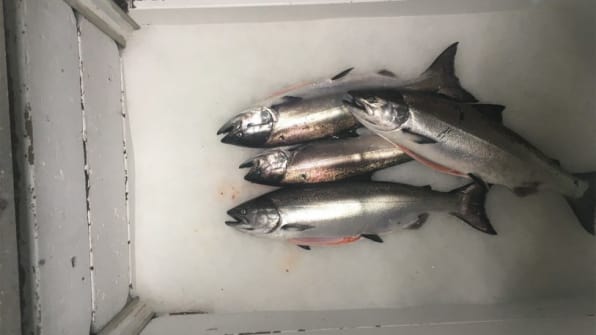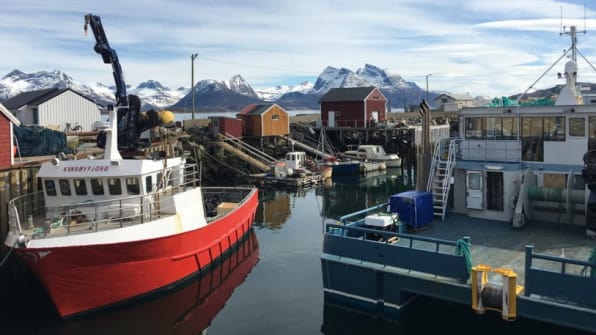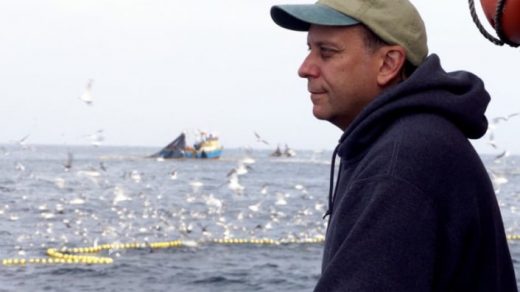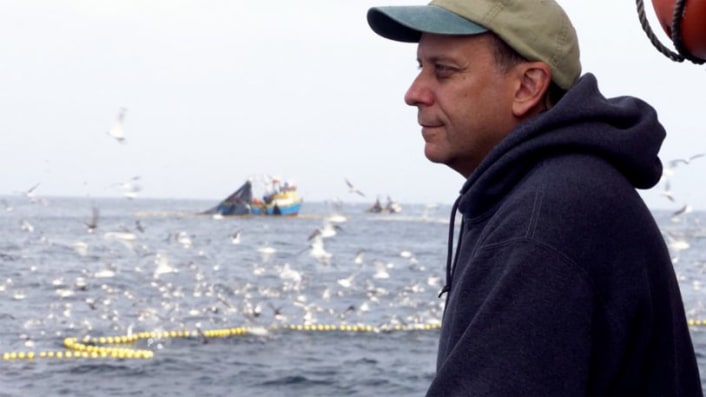Everyone Wants To Eat More Fish: Can We Find A Sustainable Way To Do It?
On September 21, 2105, lifelong fisherman and best-selling author Paul Greenberg had his blood drawn, and then he started being a strict pescatarian. For a year following that date, Greenberg ate seafood every single day, sometimes for breakfast, lunch, and dinner.
The experiment was part of research for his forthcoming book, The Omega Principle, which will investigate how the heath of the oceans ties into our own health. But it’s also the subject of a special Frontline documentary, The Fish on My Plate, premiering on April 25. Over the course of the film, Greenberg–who is currently a Pew Fellow in Marine Conservation–travels from Peru to Norway to Alaska, taking stock of fishing and farming practices across the globe while loading himself up with an inordinate amount of omega-3 fatty acids, in the form of over 700 fish-based meals, as he attempts to combat his issues with cholesterol and high blood pressure.

In a 2016 report, the Food and Agriculture Organization of the United Nations reported that the global fish consumption rate had reached an all-time high of 20 kilograms per capita. A boom in aquaculture–the practice of fish farming–which now provides half of fish for human consumption, has driven demand up, as has a growing interest in the health benefits of fish and particularly omega-3 fatty acids, which Greenberg’s personal experiment takes to its logical extreme.
Especially in light of the livestock industry, which is responsible for around 15% of global greenhouse emissions and, particularly when it comes to beef, a host of health concerns like high blood pressure and heart disease, a shift toward more fish consumption seems like a positive step in advancing sustainability in our food systems. But Greenberg (and producers David Fanning, Neil Docherty, and Sarah Spinks) find in The Fish on My Plate, it’s not nearly that simple.
For starters, there’s the fact that the average piece of fish travels over 5,000 miles before it hits a plate in America. Around 90% of the fish consumed in the U.S. is imported, yet we export around a third of what we catch locally. This system is driven by labor costs and the value of the product in various countries: In a particularly striking scene in the film, Greenberg, making the rounds at the Seafood Expo of North America in Boston, starts up a conversation with a representative of the industry in China, who tells him that wild salmon caught in Alaska will be frozen whole, sent to China to be defrosted, deboned, and packaged through less costly labor, then re-frozen and sent back to America. “That goes on our balance sheet as an import,” Greenberg tells Fast Company, and it’s still billed as wild salmon, despite the gulf between its initial harvesting and consumption.

The dichotomy between wild and farmed salmon was one that Greenberg was particularly interested in breaking down in the documentary for his American audience. To do so, he travels to Norway, the epicenter and origin of salmon farming. A multimillion dollar industry that’s responsible for 70% of the salmon we eat and has high expectations for growth, particularly in Norway, farming salmon in ocean pens and feeding them with fish meal made from high-volume fish like Peruvian anchoveta, has come under fire for its harmful effects on the surrounding environment and wild fish populations. Sea lice, an ectoparasite that is lethal to salmon, tend to multiply in particularly dense environments like fish farms. “They’re a locus for disease,” Greenberg says. Environmentalists in Norway are concerned that the industry’s rush to multiply its output of farmed salmon is interfering with natural ecosystems.
This is in contrast to Alaska, where, despite the fact that as many as one in three salmon are born in hatcheries to increase yield, the fish are released and caught in the wild. The Alaskan salmon market has differentiated itself from fish farms by selling their product in fillets, not shoving them into cans, and playing up the ethics and the taste of wild fish.
But as Greenberg points out, it’s not as simple as saying wild fish is good, and farmed fish is bad. A large part of the film is devoted to investigating more sustainable farming models: Greenberg speaks with an advocate for land-based fish farms, which negate the problem of parasites and the effects on the natural environment, and also with Bren Smith, the founder of GreenWave Farms in Branford, Connecticut, who grows clams, mussels, and oysters on ropes suspended underneath buoys, where they actually clean the surrounding ocean by soaking up nitrogen, phosphorous, and carbon; he also grows kelp, which he bills as the “new kale.” The three-acre farm, Smith says in the film, can be set up for as little as $ 10,000, and, unlike the salmon farms, requires no input of fish feed. But there’s even a more sustainable way to farm salmon: At the Kvarøy fish farm in northern Norway, a group of farmers are making headway in sustainable salmon farming by relying not on fish bred specifically to turn into feed, like anchoveta, but by using offcuts from fisheries and introducing algae as a food source for the salmon. The farms are also less densely packed, and tiny lumpsucker fish are deployed to eat up sea lice.
In The Fish on My Plate, Greenberg set out on a mission to understand both how fish affects the health of the oceans and the health of humans. For the former, the answer is complicated, but Greenberg was able to identify a variety of practices that point toward a clear, sustainable future. But when it comes to health, the answer, he found, is that “it’s a very complicated, thorny issue,” he says.
After a year of eating fish, Greenberg’s levels of omega-3 were indeed extremely high, but when his test results came back, his blood pressure was slightly elevated, and the accompanying high levels of mercury in his blood, his doctor told him, likely wiped out any of the gains in mental fortitude meant to accompany increased intake of omega-3. “I was a little disappointed,” Greenberg says. But he has a plan: After learning, through the process of making the film and writing The Omega Principle, how to select sustainably farmed and harvested fish, he’ll stick to choices like farmed mussels, clams, and oysters, “which make the sea better as they feed us,” Greenberg says. “I’ll keep eating fish, but not every fish, and not every day.”
(26)



